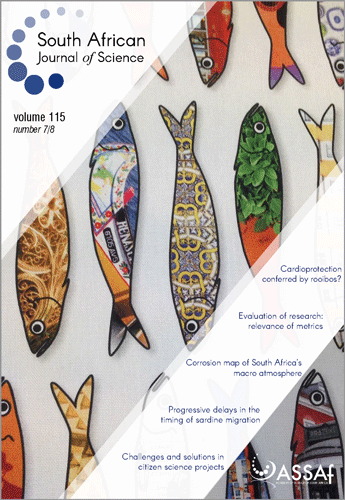Cardioprotection conferred by rooibos (Aspalathus linearis): A mini review to highlight a potential mechanism of action
DOI:
https://doi.org/10.17159/sajs.2019/4653Keywords:
South Africa, medicinal plants, novel heart drugs, heart researchAbstract
A number of cardioprotective interventions have been identified throughout the years, and these include the use of natural antioxidants in sources like rooibos (Aspalathus linearis) tea. Recent studies have demonstrated that rooibos (either its isolated components or the crude rooibos extract/tea) confers cardioprotection in diabetic cardiomyopathy and myocardial ischaemic injury. In addition, a clinical study has shown that regular rooibos consumption reduces the risk for cardiovascular disease in adults. However, rooibos is currently not considered an official treatment against cardiac disease, mainly because the underlying mechanisms for rooibos-induced cardioprotection are not fully elucidated. Physiological actions of rooibos must be well investigated before rooibos can be used in a clinical setting as adjunct treatment for patients with heart disease. Thus, research to delineate the underlying mechanisms of rooibos-induced cardioprotection is key. In the light of the aforementioned, the available literature on rooibos-induced cardioprotection is reviewed here, highlighting the fact that rooibos preserves and maintains cardiac energy homeostasis. It is postulated that rooibos activates an AMPK-GLUT-4 glucose oxidation (cardiac energy-shortage sensing) pathway to shift cardiac energy usage, thereby conferring cardioprotection.
Significance:
- It is hypothesised that rooibos may alter the way in which the human heart uses energy and oxygen, in order to protect the heart against disease. The heart’s mitochondria are responsible for the heart’s energy processes, and therefore are most likely involved in rooibos-induced cardioprotection.
- Cardioprotection conferred by rooibos is likely via an AMPK-GLUT-4 glucose oxidation pathway.
- The mechanism of cardioprotection is important for future studies investigating how rooibos alters cardiac mitochondria.
- The more information gathered about the underlying mechanisms of rooibos, the easier it will be to recommend rooibos as an official cardioprotective intervention in patients with heart disease.
Published
Issue
Section
License

All articles are published under a Creative Commons Attribution 4.0 International Licence
Copyright is retained by the authors. Readers are welcome to reproduce, share and adapt the content without permission provided the source is attributed.
Disclaimer: The publisher and editors accept no responsibility for statements made by the authors
How to Cite
- Abstract 1507
- PDF 774
- EPUB 208
- XML 430












.png)